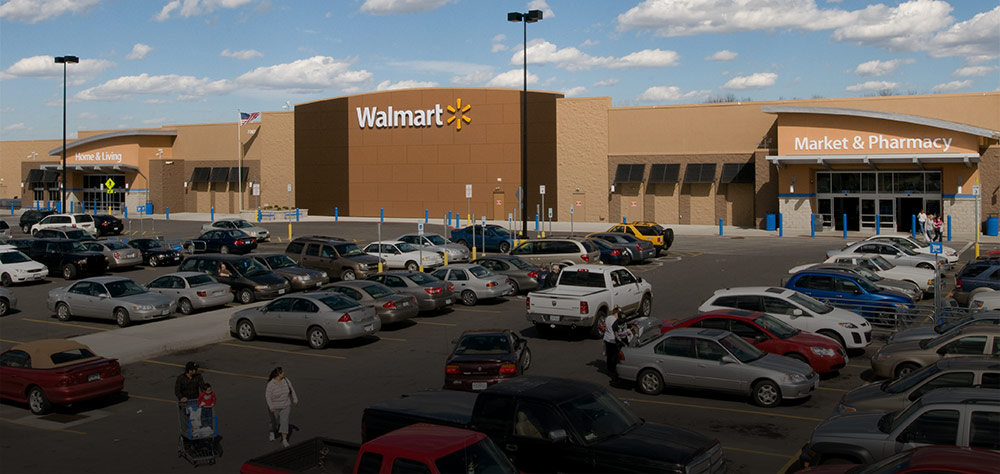(Editor’s Note: At this very moment, the Louisville Board of Zoning Adjustments (BOZA) is hearing Walmart’s case for variances to allow it to build an exurban Supercenter in Louisville’s urban core. This article from smart growth advocacy group Strong Towns tackles the issue of Walmart from another angle: the cycle of poverty that sustains the mega-retailer. It appears here with permission.)
Whether you are stumbling on Strong Towns for the first time today, or whether you’ve been a Strong Towns advocate for years, you’re probably not a fan of Walmart. Big box stores are not really our thing here. We know that they create a far smaller tax base than your average mom and pop shop, that they take economic value out of our communities, and that they dominate town landscapes with their unnecessarily massive parking lots and ugly buildings. But there’s another problem with Walmart, and it matters because it hits the most vulnerable people hardest: The problem is that Walmart systematically depends on the poverty of communities.
Indeed, Walmart would not exist without poor people. First, Walmart needs them to work in its stores. Walmart needs people so desperate for employment that they will be willing to go 10 hours without a break, accept wages below the poverty line (causing a drain on public benefits), and never have a forum to address their grievances. Second, Walmart needs people to buy their products, and a good portion of those customers are poor. These forces combine to make Walmart a significant player in creating and sustaining poverty in towns across America. I suspect other big box stores have a similar effect on poverty in their communities, but Walmart is a clearly documented and particularly problematic example.
There have been several articles and papers on this topic, but for time’s sake, I’ll just talk about one today. A decade ago, two professors from Penn State, Stephan Goetz and Hema Swaminathan, came out with a study called, “Walmart and County-Wide Poverty.” Using econometrics and building off previous studies, the authors concluded that counties which added Walmart stores or had a considerable amount of Walmart stores over a period of 11 years (between 1987 and 1998) saw higher poverty rates than counties that did not. They write, “These results have potentially profound implications for public policy related to big box operations. In particular, the chain is not the engine of local economic growth that the company’s spokespersons and public relations materials suggest.” Indeed, in several counties, Walmart has been responsible for stagnation and decline.
That comes, in part, from Walmart’s insistence on keeping its employees at very low wage rates. Despite employing over 2 million people in the world, the average Walmart “associate” makes just $8.86 per hour, which amounts to well under $20,000 annually if that employee were working full time. (Walmart recently announced a wage increase to $9.00 per hour, but that move has people questioning the corporation’s intentions.) And when you account for the fact that many employees are intentionally made to work part time (thus cutting them off from benefits), the average annual salary is even lower. On top of that, these employees’ hours are often unpredictable, making holding additional part-time jobs a serious challenge. All of this means that in counties where Walmart is a major employer, much of the population is living near or below the poverty line because they have no other option.
As a result, many of them rely on public benefits like Medicaid and the Supplemental Nutrition Assistance Program (food stamps) to survive, which naturally creates a big drain on government resources in those communities. Forbes reported that Walmart workers cost taxpayers $6.2 billion in public assistance in 2013. We already know that stores like this disrupt the fabric of our towns by undercutting local businesses and pulling profit away from the community, but its disturbing to acknowledge that Walmart is also intentionally creating a population that relies on public benefits when it could afford to pay its employees more—enough to actually thrive on—if only it didn’t pay its owners so much. Instead, Walmart leadership has chosen to keep millions of people underemployed to fuel its own greed.
Now, Walmart doesn’t just rely on its poor employees, it also relies on poor customers to buy its cheap junk. The average Walmart customer has a household income of less than $40,000 a year and 1/6th are on food stamps. (Side note: This is yet another way that Walmart profits off of and depends upon public benefits—thousands of dollars in food stamps are being spent on Walmart products every day.) This is not to say that wealthier people don’t choose to shop at Walmart; they do. But the operative word there is “choose.” Most middle and upper class families would easily relocate their purchases to another store if Walmart wasn’t convenient for them, or if Walmart didn’t exist.
Low-income individuals, on the other hand, have far fewer options. Particularly in more rural or suburban areas where transportation is costly and time-consuming, and most local businesses have been squeezed out by big box stores—poor families have little choice but to make their purchases at Walmart. Walmart becomes their one stop shop. Unsurprisingly, a large percentage of Walmart customers are also its employees, meaning that Walmart is something like an enclosed, greed-based system which keeps feeding off itself and siphoning profits to a handful of people at the very top. It exists only to benefit them. As one former employee explains in an exposé on Gawker: “Walmart permits employees to cash their paychecks at the register which is commonly eaten up by their cartfuls of food and other necessities. This company perpetuates a system where employee earnings flow right back to this colossal unseeing and uncaring corporation.”
In short, while there are many factors that create and sustain poverty in America, counties with a Walmart have a greater likelihood of being low-income, and keeping their residents trapped in that cycle of poverty. If we didn’t have enough reasons to fight against Walmart’s encroachment into our towns, now we certainly do.
(This article by Rachel Quednau has been cross-posted from Strong Towns. Quednau is a Midwesterner currently working to end homelessness in Milwaukee, WI. She draws from her experiences living in New York City, Washington, DC, Walla Walla, WA and Minneapolis, MN to help her build better places wherever she is. Rachel writes for her blog, The City Space, for Urban Milwaukee, and contributes to Strong Towns. Top image courtesy Walmart.)




According to KIPDA 1 in 6 Jefferson County residents has below poverty income. Thats about 119,569 people of whom 41.5 % are over 65. Poverty wage for 1 adult and two children families is $ 8.80 and a living wage is $ 21.59. $ 8.28 is the living hourly full time wage for a single adult. The average hourly compensation of workers in China in 2009 U.S. Dollars was $ 2.85. (U.S. Bureau Labor Statistics).
A pool of desperate workers willing to take anything serves to depress wages for even higher skilled employees. The questions asked about resisting poor pay and working conditions in Mexico maquiladoras could well be asked in Louisville:
“Could migrants from rural Chihuahua and other parts of Mexico lack the means and organizational experience to mobilize effectively against powerful transnational companies allied with local governments?”
Nobody would mind when Forbes announces 1,826 billionaires in 2015 owning $ trillions, if the spectacle of grinding poverty poor health and all the social ills were not forced upon a sixth of the population so that the 1% could live with embarrassing riches.
Thanks for sharing this article. We have said much the same many times. As noted in our remarks to BOZA yesterday, the claims used to support Walmart have been mythic in proportion and unsupported by fact. We have long called Walmart out for its low wages, part-time work and the “walmarting ” of the general economy. If low wage, part-time jobs were so transformative, why haven’t the many dollar stores in the west, south and southwest increased the ranks of the “middle class” exponentially? In actuality, box-stores, dollar stores and fast food chains lock workers into a cycle of subsistence living….. and the mind-set that nothing more is possible or deserved. Thus, such projects have a “ghettoizing effect”, where employees and their communities have only limited horizons to anticipate. Meanwhile, the Waltons of Arkansas enjoy boundless wealth on the shoulders of the working poor they employ and a customer base they respect so little that they won’t even make concessions for safer, more accessible design. West Louisville and Louisville deserves better.